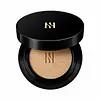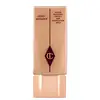What's inside
What's inside
 Key Ingredients
Key Ingredients

 Benefits
Benefits

 Concerns
Concerns

 Ingredients Side-by-side
Ingredients Side-by-side

Water
Skin ConditioningCyclopentasiloxane
EmollientMethyl Trimethicone
Skin ConditioningButylene Glycol
HumectantEthylhexyl Methoxycinnamate
UV AbsorberCI 77891
Cosmetic ColorantMica
Cosmetic ColorantCyclohexasiloxane
EmollientTrimethylsiloxysilicate
EmollientPEG-10 Dimethicone
Skin ConditioningDisteardimonium Hectorite
StabilisingCI 77947
Methyl Methacrylate Crosspolymer
Lauryl PEG-9 Polydimethylsiloxyethyl Dimethicone
Skin ConditioningDimethicone
EmollientCI 77492
Cosmetic ColorantAcrylates/Ethylhexyl Acrylate/Dimethicone Methacrylate Copolymer
Skin ConditioningAcrylates/Stearyl Acrylate/Dimethicone Methacrylate Copolymer
Sodium Chloride
MaskingAluminum Hydroxide
EmollientGlycerin
HumectantParfum
MaskingCI 77491
Cosmetic ColorantPolysorbate 40
EmulsifyingPolysilicone-11
Polysorbate 80
EmulsifyingCaprylyl Glycol
EmollientTriethoxycaprylylsilane
Lauroyl Lysine
Skin ConditioningStearic Acid
CleansingHydrogenated Lecithin
EmulsifyingPolyhydroxystearic Acid
EmulsifyingEthylhexylglycerin
Skin ConditioningCI 77499
Cosmetic ColorantDisodium EDTA
Lecithin
EmollientEthylhexyl Palmitate
EmollientIsostearic Acid
CleansingIsopropyl Palmitate
EmollientPolyglyceryl-3 Polyricinoleate
EmulsifyingWater, Cyclopentasiloxane, Methyl Trimethicone, Butylene Glycol, Ethylhexyl Methoxycinnamate, CI 77891, Mica, Cyclohexasiloxane, Trimethylsiloxysilicate, PEG-10 Dimethicone, Disteardimonium Hectorite, CI 77947, Methyl Methacrylate Crosspolymer, Lauryl PEG-9 Polydimethylsiloxyethyl Dimethicone, Dimethicone, CI 77492, Acrylates/Ethylhexyl Acrylate/Dimethicone Methacrylate Copolymer, Acrylates/Stearyl Acrylate/Dimethicone Methacrylate Copolymer, Sodium Chloride, Aluminum Hydroxide, Glycerin, Parfum, CI 77491, Polysorbate 40, Polysilicone-11, Polysorbate 80, Caprylyl Glycol, Triethoxycaprylylsilane, Lauroyl Lysine, Stearic Acid, Hydrogenated Lecithin, Polyhydroxystearic Acid, Ethylhexylglycerin, CI 77499, Disodium EDTA, Lecithin, Ethylhexyl Palmitate, Isostearic Acid, Isopropyl Palmitate, Polyglyceryl-3 Polyricinoleate
Cyclopentasiloxane
EmollientWater
Skin ConditioningHydrogenated Didodecene
Ethylhexyl Methoxycinnamate
UV AbsorberMica
Cosmetic ColorantGlycerin
HumectantSorbitan Isostearate
EmulsifyingTitanium Dioxide
Cosmetic ColorantPEG/PPG-18/18 Dimethicone
EmulsifyingSodium Chloride
MaskingCyclohexasiloxane
EmollientAluminum/Magnesium Hydroxide Stearate
Emulsion StabilisingDimethicone/Vinyl Dimethicone Crosspolymer
Skin ConditioningCetearyl Ethylhexanoate
EmollientSqualane
EmollientDimethicone
EmollientDisodium Cocoyl Glutamate
CleansingMethylparaben
PreservativePotassium Sorbate
PreservativeIsopropyl Titanium Triisostearate
EmollientPropylparaben
PreservativeSilica
AbrasiveParfum
MaskingSodium Cocoyl Glutamate
CleansingAluminum Hydroxide
EmollientLaureth-4
EmulsifyingPentaerythrityl Tetra-Di-T-Butyl Hydroxyhydrocinnamate
AntioxidantBHT
AntioxidantCI 77891
Cosmetic ColorantIron Oxides
Cyclopentasiloxane, Water, Hydrogenated Didodecene, Ethylhexyl Methoxycinnamate, Mica, Glycerin, Sorbitan Isostearate, Titanium Dioxide, PEG/PPG-18/18 Dimethicone, Sodium Chloride, Cyclohexasiloxane, Aluminum/Magnesium Hydroxide Stearate, Dimethicone/Vinyl Dimethicone Crosspolymer, Cetearyl Ethylhexanoate, Squalane, Dimethicone, Disodium Cocoyl Glutamate, Methylparaben, Potassium Sorbate, Isopropyl Titanium Triisostearate, Propylparaben, Silica, Parfum, Sodium Cocoyl Glutamate, Aluminum Hydroxide, Laureth-4, Pentaerythrityl Tetra-Di-T-Butyl Hydroxyhydrocinnamate, BHT, CI 77891, Iron Oxides
Ingredients Explained
These ingredients are found in both products.
Ingredients higher up in an ingredient list are typically present in a larger amount.
Aluminum Hydroxide is a form of aluminum. It can be naturally found in nature as the mineral gibbsite. In cosmetics, Aluminum Hydroxide is used as a colorant, pH adjuster, and absorbent.
As a colorant, Aluminum Hydroxide may add opacity, or reduce the transparency. Aluminum hydroxide is contains both basic and acidic properties.
According to manufacturers, this ingredient is an emollient and humectant. This means it helps hydrate the skin.
In medicine, this ingredient is used to help relieve heartburn and help heal ulcers.
There is currently no credible scientific evidence linking aluminum hydroxide in cosmetics to increased cancer risk.
Major health organizations allow the use of aluminum hydroxide in personal care products and have not flagged it as a carcinogenic risk at typical usage levels.
Learn more about Aluminum HydroxideCi 77891 is a white pigment from Titanium dioxide. It is naturally found in minerals such as rutile and ilmenite.
It's main function is to add a white color to cosmetics. It can also be mixed with other colors to create different shades.
Ci 77891 is commonly found in sunscreens due to its ability to block UV rays.
Learn more about CI 77891Cyclohexasiloxane is a type of silicone more commonly known as D6. It is an emollient and solvent.
Cyclohexasiloxane is used to evenly distribute ingredients throughout the product. When applied to the skin, Cyclohexasiloxane evaporates and leaves behind a silky feel.
As an emollient, it can help the skin feel soft and hydrated. It is also used to reduce frizz in hair products.
Learn more about CyclohexasiloxaneCyclopentasiloxane, or D5, is a silicone used to improve texture of products and trap moisture.
D5 is considered lightweight and volatile. Volatile means it evaporates quickly after application. Once evaporated, D5 leaves a thin barrier that helps keep skin hydrated.
It is also an emollient. Emollients help soften the skin and prevent water loss. Silicones create a silky texture in products. D5 helps other ingredients become more spreadable.
Studies show D5 is safe to use in skincare products. We recommend speaking with a skincare professional if you have concerns.
Learn more about CyclopentasiloxaneDimethicone is a type of synthetic silicone created from natural materials such as quartz.
What it does:
Dimethicone comes in different viscosities:
Depending on the viscosity, dimethicone has different properties.
Ingredients lists don't always show which type is used, so we recommend reaching out to the brand if you have questions about the viscosity.
This ingredient is unlikely to cause irritation because it does not get absorbed into skin. However, people with silicone allergies should be careful about using this ingredient.
Note: Dimethicone may contribute to pilling. This is because it is not oil or water soluble, so pilling may occur when layered with products. When mixed with heavy oils in a formula, the outcome is also quite greasy.
Learn more about DimethiconeEthylhexyl Methoxycinnamate is an organic compound that provides UVB protection. It often goes by the more common name of octinoxate. It is created from methoxycinnamic acid and 2-ethylhexanol.
Ethylhexyl Methoxycinnamate absorbs UVB rays with wavelengths between 280-320 nm. UV absorbers protect your skin by using chemical reactions to convert UV rays into heat and energy.
UVB (290-320 nm) rays emit more energy than UVA rays. They are capable of damaging DNA, causing sunburns and are thought to be linked to skin cancer.
The state of Hawaii has banned sunscreens containing octinoxate due to its potential impact on coral reefs. More research is needed to bridge gaps in this research. The European Union allows higher levels of octinoxate in sunscreens than the US and Australia.
Ethylhexyl Methoxycinnamate is oil soluble. It is not stable and may lose efficacy when exposed to sunlight.
Learn more about Ethylhexyl MethoxycinnamateGlycerin is already naturally found in your skin. It helps moisturize and protect your skin.
A study from 2016 found glycerin to be more effective as a humectant than AHAs and hyaluronic acid.
As a humectant, it helps the skin stay hydrated by pulling moisture to your skin. The low molecular weight of glycerin allows it to pull moisture into the deeper layers of your skin.
Hydrated skin improves your skin barrier; Your skin barrier helps protect against irritants and bacteria.
Glycerin has also been found to have antimicrobial and antiviral properties. Due to these properties, glycerin is often used in wound and burn treatments.
In cosmetics, glycerin is usually derived from plants such as soybean or palm. However, it can also be sourced from animals, such as tallow or animal fat.
This ingredient is organic, colorless, odorless, and non-toxic.
Glycerin is the name for this ingredient in American English. British English uses Glycerol/Glycerine.
Learn more about GlycerinMica is a naturally occurring mineral used to add shimmer and color in cosmetics. It can also help improve the texture of a product or give it an opaque, white/silver color.
Serecite is the name for very fine but ragged grains of mica.
This ingredient is often coated with metal oxides like titanium dioxide. Trace amounts of heavy metals may be found in mica, but these metals are not harmful in our personal products.
Mica has been used since prehistoric times throughout the world. Ancient Egyptian, Indian, Greek, Roman, Aztec, and Chinese civilizations have used mica.
Learn more about MicaParfum is a catch-all term for an ingredient or more that is used to give a scent to products.
Also called "fragrance", this ingredient can be a blend of hundreds of chemicals or plant oils. This means every product with "fragrance" or "parfum" in the ingredients list is a different mixture.
For instance, Habanolide is a proprietary trade name for a specific aroma chemical. When used as a fragrance ingredient in cosmetics, most aroma chemicals fall under the broad labeling category of “FRAGRANCE” or “PARFUM” according to EU and US regulations.
The term 'parfum' or 'fragrance' is not regulated in many countries. In many cases, it is up to the brand to define this term.
For instance, many brands choose to label themselves as "fragrance-free" because they are not using synthetic fragrances. However, their products may still contain ingredients such as essential oils that are considered a fragrance by INCI standards.
One example is Calendula flower extract. Calendula is an essential oil that still imparts a scent or 'fragrance'.
Depending on the blend, the ingredients in the mixture can cause allergies and sensitivities on the skin. Some ingredients that are known EU allergens include linalool and citronellol.
Parfum can also be used to mask or cover an unpleasant scent.
The bottom line is: not all fragrances/parfum/ingredients are created equally. If you are worried about fragrances, we recommend taking a closer look at an ingredient. And of course, we always recommend speaking with a professional.
Learn more about ParfumChances are, you eat sodium chloride every day. Sodium Chloride is also known as table salt.
This ingredient has many purposes in skincare: thickener, emulsifier, and exfoliator.
You'll most likely find this ingredient in cleansers where it is used to create a gel-like texture. As an emulsifier, it also prevents ingredients from separating.
There is much debate on whether this ingredient is comedogenic. The short answer - comedogenic ratings don't tell the whole story. Learn more about comegodenic ratings here.
The concensus about this ingredient causing acne seems to be divided. Research is needed to understand if this ingredient does cause acne.
Scrubs may use salt as the primary exfoliating ingredient.
Learn more about Sodium ChlorideWater. It's the most common cosmetic ingredient of all. You'll usually see it at the top of ingredient lists, meaning that it makes up the largest part of the product.
So why is it so popular? Water most often acts as a solvent - this means that it helps dissolve other ingredients into the formulation.
You'll also recognize water as that liquid we all need to stay alive. If you see this, drink a glass of water. Stay hydrated!
Learn more about Water